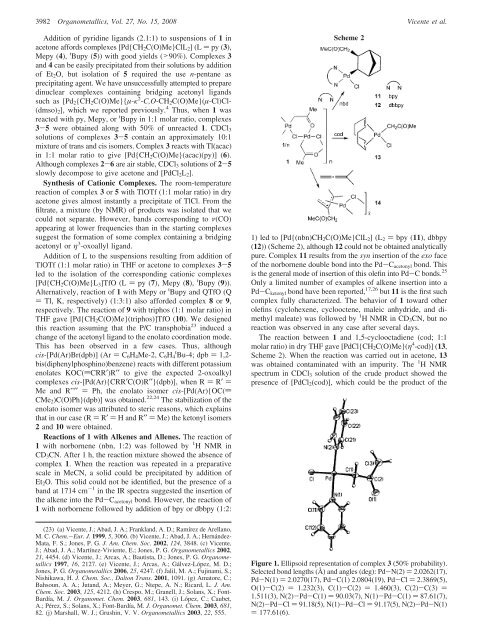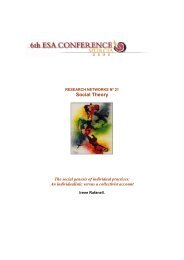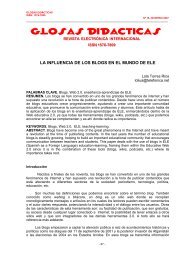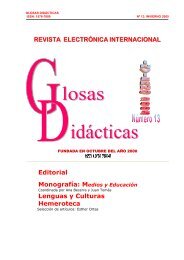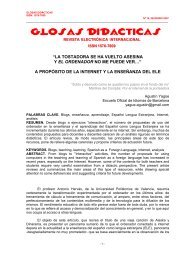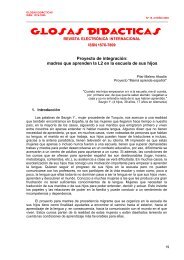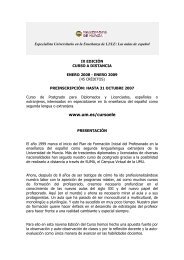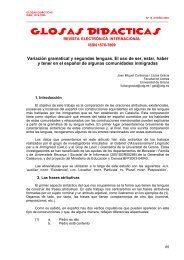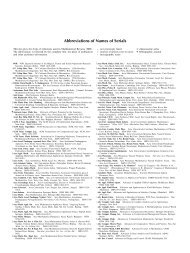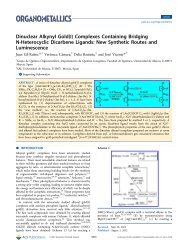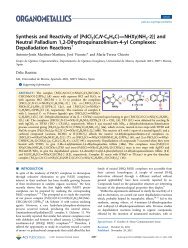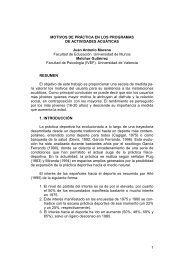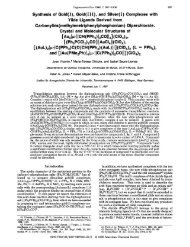New Acetonyl Palladium(II) Complexes - Universidad de Murcia
New Acetonyl Palladium(II) Complexes - Universidad de Murcia
New Acetonyl Palladium(II) Complexes - Universidad de Murcia
You also want an ePaper? Increase the reach of your titles
YUMPU automatically turns print PDFs into web optimized ePapers that Google loves.
3982 Organometallics, Vol. 27, No. 15, 2008 Vicente et al.<br />
Addition of pyridine ligands (2.1:1) to suspensions of 1 in<br />
acetone affords complexes [Pd{CH 2 C(O)Me}ClL 2 ](L) py (3),<br />
Mepy (4), t Bupy (5)) with good yields (>90%). <strong>Complexes</strong> 3<br />
and 4 can be easily precipitated from their solutions by addition<br />
of Et 2 O, but isolation of 5 required the use n-pentane as<br />
precipitating agent. We have unsuccessfully attempted to prepare<br />
dinuclear complexes containing bridging acetonyl ligands<br />
such as [Pd 2 {CH 2 C(O)Me}{µ-κ 2 -C,O-CH 2 C(O)Me}(µ-Cl)Cl-<br />
(dmso) 2 ], which we reported previously. 4 Thus, when 1 was<br />
reacted with py, Mepy, or t Bupy in 1:1 molar ratio, complexes<br />
3-5 were obtained along with 50% of unreacted 1. CDCl 3<br />
solutions of complexes 3-5 contain an approximately 10:1<br />
mixture of trans and cis isomers. Complex 3 reacts with Tl(acac)<br />
in 1:1 molar ratio to give [Pd{CH 2 C(O)Me}(acac)(py)] (6).<br />
Although complexes 2-6 are air stable, CDCl 3 solutions of 2-5<br />
slowly <strong>de</strong>compose to give acetone and [PdCl 2 L 2 ].<br />
Synthesis of Cationic <strong>Complexes</strong>. The room-temperature<br />
reaction of complex 3 or 5 with TlOTf (1:1 molar ratio) in dry<br />
acetone gives almost instantly a precipitate of TlCl. From the<br />
filtrate, a mixture (by NMR) of products was isolated that we<br />
could not separate. However, bands corresponding to ν(CO)<br />
appearing at lower frequencies than in the starting complexes<br />
suggest the formation of some complex containing a bridging<br />
acetonyl or η 3 -oxoallyl ligand.<br />
Addition of L to the suspensions resulting from addition of<br />
TlOTf (1:1 molar ratio) in THF or acetone to complexes 3-5<br />
led to the isolation of the corresponding cationic complexes<br />
[Pd{CH 2 C(O)Me}L 3 ]TfO (L ) py (7), Mepy (8), t Bupy (9)).<br />
Alternatively, reaction of 1 with Mepy or t Bupy and QTfO (Q<br />
) Tl, K, respectively) (1:3:1) also affor<strong>de</strong>d complex 8 or 9,<br />
respectively. The reaction of 9 with triphos (1:1 molar ratio) in<br />
THF gave [Pd{CH 2 C(O)Me}(triphos)]TfO (10). We <strong>de</strong>signed<br />
this reaction assuming that the P/C transphobia 23 induced a<br />
change of the acetonyl ligand to the enolato coordination mo<strong>de</strong>.<br />
This has been observed in a few cases. Thus, although<br />
cis-[Pd(Ar)Br(dpb)] (Ar ) C 6 H 4 Me-2, C 6 H 4 t Bu-4; dpb ) 1,2-<br />
bis(diphenylphosphino)benzene) reacts with different potassium<br />
enolates KOC(dCRR′)R′′ to give the expected 2-oxoalkyl<br />
complexes cis-[Pd(Ar){CRR′C(O)R′′}(dpb)], when R ) R′ )<br />
Me and R”′′ ) Ph, the enolato isomer cis-[Pd(Ar){OC(d<br />
CMe 2 )C(O)Ph}(dpb)] was obtained. 22,24 The stabilization of the<br />
enolato isomer was attributed to steric reasons, which explains<br />
that in our case (R ) R′ ) H and R′′ ) Me) the ketonyl isomers<br />
2 and 10 were obtained.<br />
Reactions of 1 with Alkenes and Allenes. The reaction of<br />
1 with norbornene (nbn, 1:2) was followed by 1 H NMR in<br />
CD 3 CN. After 1 h, the reaction mixture showed the absence of<br />
complex 1. When the reaction was repeated in a preparative<br />
scale in MeCN, a solid could be precipitated by addition of<br />
Et 2 O. This solid could not be i<strong>de</strong>ntified, but the presence of a<br />
band at 1714 cm -1 in the IR spectra suggested the insertion of<br />
the alkene into the Pd-C acetonyl bond. However, the reaction of<br />
1 with norbornene followed by addition of bpy or dbbpy (1:2:<br />
Scheme 2<br />
1) led to [Pd{(nbn)CH 2 C(O)Me}ClL 2 ](L 2 ) bpy (11), dbbpy<br />
(12)) (Scheme 2), although 12 could not be obtained analytically<br />
pure. Complex 11 results from the syn insertion of the exo face<br />
of the norbornene double bond into the Pd-C acetonyl bond. This<br />
is the general mo<strong>de</strong> of insertion of this olefin into Pd-C bonds. 25<br />
Only a limited number of examples of alkene insertion into a<br />
Pd-C ketonyl bond have been reported, 17,26 but 11 is the first such<br />
complex fully characterized. The behavior of 1 toward other<br />
olefins (cyclohexene, cyclooctene, maleic anhydri<strong>de</strong>, and dimethyl<br />
maleate) was followed by 1 H NMR in CD 3 CN, but no<br />
reaction was observed in any case after several days.<br />
The reaction between 1 and 1,5-cyclooctadiene (cod; 1:1<br />
molar ratio) in dry THF gave [PdCl{CH 2 C(O)Me}(η 4 -cod)] (13,<br />
Scheme 2). When the reaction was carried out in acetone, 13<br />
was obtained contaminated with an impurity. The 1 H NMR<br />
spectrum in CDCl 3 solution of the cru<strong>de</strong> product showed the<br />
presence of [PdCl 2 (cod)], which could be the product of the<br />
(23) (a) Vicente, J.; Abad, J. A.; Frankland, A. D.; Ramírez <strong>de</strong> Arellano,<br />
M. C. Chem.-Eur. J. 1999, 5, 3066. (b) Vicente, J.; Abad, J. A.; Hernán<strong>de</strong>z-<br />
Mata, F. S.; Jones, P. G. J. Am. Chem. Soc. 2002, 124, 3848. (c) Vicente,<br />
J.; Abad, J. A.; Martínez-Viviente, E.; Jones, P. G. Organometallics 2002,<br />
21, 4454. (d) Vicente, J.; Arcas, A.; Bautista, D.; Jones, P. G. Organometallics<br />
1997, 16, 2127. (e) Vicente, J.; Arcas, A.; Gálvez-López, M. D.;<br />
Jones, P. G. Organometallics 2006, 25, 4247. (f) Jalil, M. A.; Fujinami, S.;<br />
Nishikawa, H. J. Chem. Soc., Dalton Trans. 2001, 1091. (g) Amatore, C.;<br />
Bahsoun, A. A.; Jutand, A.; Meyer, G.; Ntepe, A. N.; Ricard, L. J. Am.<br />
Chem. Soc. 2003, 125, 4212. (h) Crespo, M.; Granell, J.; Solans, X.; Font-<br />
Bardía, M. J. Organomet. Chem. 2003, 681, 143. (i) López, C.; Caubet,<br />
A.; Pérez, S.; Solans, X.; Font-Bardía, M. J. Organomet. Chem. 2003, 681,<br />
82. (j) Marshall, W. J.; Grushin, V. V. Organometallics 2003, 22, 555.<br />
Figure 1. Ellipsoid representation of complex 3 (50% probability).<br />
Selected bond lengths (Å) and angles (<strong>de</strong>g): Pd-N(2) ) 2.0262(17),<br />
Pd-N(1) ) 2.0270(17), Pd-C(1) 2.0804(19), Pd-Cl ) 2.3869(5),<br />
O(1)-C(2) ) 1.232(3), C(1)-C(2) ) 1.460(3), C(2)-C(3) )<br />
1.511(3), N(2)-Pd-C(1) ) 90.03(7), N(1)-Pd-C(1) ) 87.61(7),<br />
N(2)-Pd-Cl ) 91.18(5), N(1)-Pd-Cl ) 91.17(5), N(2)-Pd-N(1)<br />
) 177.61(6).


